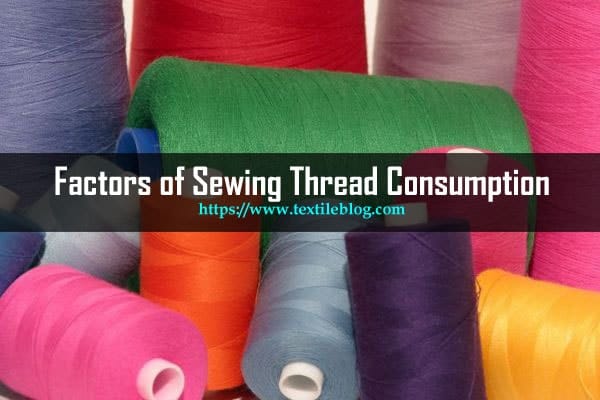Sewing Thread Calculation:
Sewing thread is an important raw material in the apparel industry. The calculation of sewing thread consumption is very important factor and should be done accurately else will lead to excess stock on hand. There are various factors which influence the sewing thread consumption. They include:
1. Stitch density:
Stitch density means stitches per inch or stitches per cm. higher the stitches per unit length, higher the consumption of sewing threads or vice versa.
2. Fabric thickness:
Fabric thickness also plays an important role in the sewing thread consumption. The stitch depth or stitch height is directly proportional to the fabric thickness. If the fabric thickness is more, and then the stitch depth will be high or vice versa. So the consumption of sewing thread will be more if the fabric thickness is high.

3. Seam/stitch width:
Seam/stitch width refers to the measurement of the seam/stitch from the fabric edge to the inside seam/stitch border. Higher the seam/stitch width, higher the consumption of sewing thread or vice versa.
4. Seam/stitch length:
Seam/stitch length refers to the length of fabric edges which are to be sewn. Higher the seam/stitch length, higher the consumption of sewing thread or vice versa.
5. Sewing thread tension:
The thread tension will alter the thread requirement according to setting. This can change the ratio between needle, bobbin and if applicable cover thread. It can also greatly influence the amount of the overall thread consumption.
6. Number of sewing threads:
A stitch can be formed by using single thread or multiple threads. There are single thread stitch, double thread stitch, three thread or four thread stitch etc. If the number of threads is more, then the fabric consumption is high.
7. Stitch type:
There are different classifications of stitch types like chain stitch, lock stitch, blind stitch, over-edge stitch etc. The sewing thread consumption will vary depends on the type of stitches used.
8. Seam type:
There are different classifications of seam types like plain seam, French seam, super imposed seam etc. the sewing thread consumption will vary depends on the type of seams used.
Sewing thread requirement: Stitch type wise
The approximate sewing thread requirement for various stitch types are as given below:
(NT – Needle Thread; BT – Bobbin/Looper Thread; CT – Cover Thread)
| Stitch type | Seam width (mm) | Stitches/cm | Thread requirement per 1 mtr of seam | Percentage (%) |
| Single thread chain stitch (101) | – | 2 | NT: 3.8 m | 100% |
| Single thread blind stitch (103) | – | 2 | NT: 4.5 m | 100% |
| Single thread blind stitch (105) | – | 2 | NT: 4.5 m | 100% |
| Lock stitch (205) | – | 4 | NT : 1.4 m | 100% |
| Double lock stitch (301) | – | 4 | NT: 1.4 m BT: 1.4 m/2.8 m | 50% 50% |
| Double lock stitch Zig-Zag (304) | 5 | 4 | NT: 2.7 m BT: 2.7 m/5.4 m | 50% 50% |
| Double chain stitch | – | 4 | NT: 1.50 m BT: 2.80 m/4.30m | 35% 65% |
| Two needle double chain stitch (406) | 5 | 4 | NT: 3.40 m BT: 8.40 m/11.80m | 29% 71% |
| Single thread over edge stitch (501) | 7 | 4 | NT : 16.4 m | 100% |
| Two needle covering chain stitch (605) | 6 | 4 | NT: 3.40 m BT: 8.40 m CT: 5.10 m/16.90m | 20% 50% 30% |
Sewing thread requirement – Garment wise
The data to calculate approximate amount of thread consumption are given in the below table. The figures given are based on the fashionable and qualitative characteristics of the individual garment listed. This means that standard thread amount indicated are not arithmetical mean values derived from the maximum and minimum values shown in the Range of Variations column. They already include allowances for the start and end if seams as well as color changes.
| Garment style | Standard Amount (m) | Range of Variation (m) | Overlocking seams (m) | Assembly & ornamental seams (m) |
| Men’s and Boy’s wear | ||||
| Blue denim jeans | 280 | 230-370 | 130 | 150 |
| Sack coat, blazer | 190 | 170-240 | 45 | 145 |
| Shorts | 90 | 80-100 | 50 | 40 |
| Bathing/Dressing gown | 210 | 170-250 | 110 | 100 |
| Underwear/ Lingerie | ||||
| Ladies panties, Men’s briefs | 100 | 80-100 | 80 | 20 |
| Bra | 55 | 40-80 | 20 | 35 |
| Pyjama | 200 | 170-200 | 120 | 80 |
| Night gown | 150 | 130-150 | 100 | 50 |
| Ladies wear | ||||
| Dress (unlined) | 150 | 125-180 | 90 | 60 |
| Dress (lined) | 195 | 160-255 | 100 | 95 |
| Jacked | 200 | 170-250 | 60 | 140 |
| Blouse | 120 | 100-150 | 55 | 65 |
We know that sewing thread is an essential trimming in garment sewing. In this article I have discussed about factors which affect sewing thread consumption. I have also discussed above requirements of sewing thread with stitch type and garment wise. If this article become helpful for you then don’t forget to share in your community.
